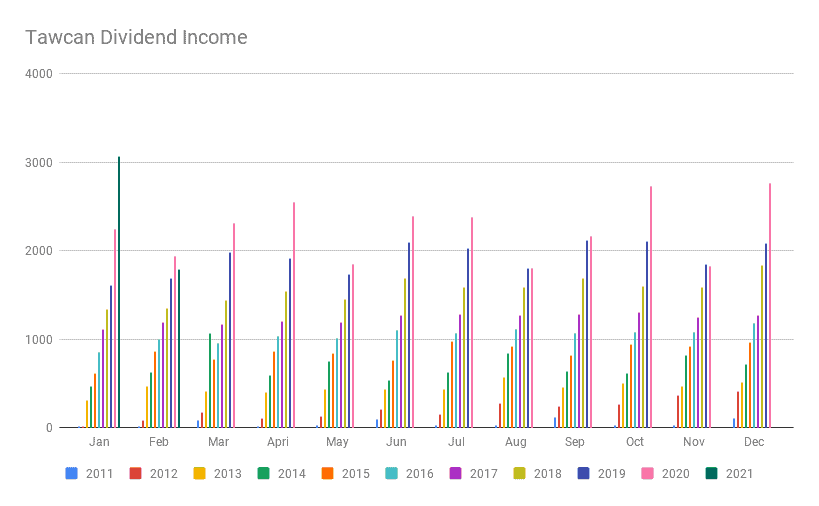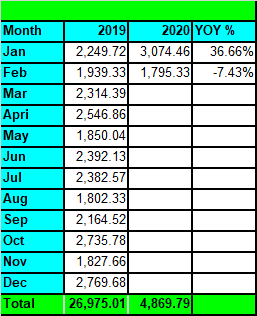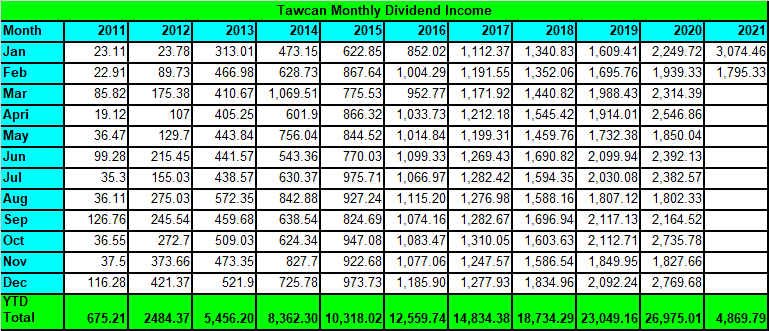Well, it was another month where we stayed home mostly due to the provincial restrictions. It’s crazy to think that March 14, 2020 was when we first started staying at home to prevent the spread of COVID-19. The world certainly has changed a lot in the last year hasn’t it?
It also has been interesting and go back to read some COVID related posts I wrote around this time last year…
- Random Thoughts – Stock sell-offs, Coronavirus, Recession Coming?
- What you should be doing in the midst of the COVID-19 pandemic
- How the COVID-19 pandemic changed our financial independence retire early (FIRE) plan
- Creative Ways We Saved & Earned During the COVID-19 Pandemic
- Admitting that I’m not OK… and be OK with this new reality
I’ll be the first one to admit that I was really naïve about this global pandemic. I certainly didn’t see things unfold the way they did. Here we are, a year later, and the virus is still at large around the world…
But there’s light at the end of the tunnel. I’m optimistic that the rollout of vaccines will help us get back to the old normal and we can hug each other again. It will soon be possible to meet up with friends in person and attend conferences. What I have really missed is having dim sum at a restaurant with my parents, my brother’s family, Mrs. T, and my kids. Hopefully, we’ll be able to do that together soon.
This picture from Maui three years ago popped up the other day in Google Photos. Boy, I’d love to go back there soon! I certainly have missed travelling and seeing different parts of the world the past year.
Dividend Income – February 2021
Back to the main topic, shall we?
In February 2021 we received dividends from the following companies:
- Apple (AAPL)
- AbbVie (ABBV)
- Bank of Montreal (BMO.TO)
- Costco (COST)
- Dream Office REIT (D.UN)
- Dream Industrial REIT (DIR.UN)
- Emera (EMA.TO)
- European Residential REIT (ERE.UN)
- Granite REIT (GRT.UN)
- H&R REIT (HR.UN)
- Inter Pipeline (IPL.TO)
- KEG Income Trust (KEG.UN)
- National Bank (NA.TO)
- Omega Healthcare (OHI)
- Procter & Gamble (PG)
- RioCan REIT (REI.UN)
- Royal Bank (RY.TO)
- SmartCentre REIT (SMR.UN)
- AT&T (T)
- Verizon (VZ)

After a record breaking January where we received over $3,000 in dividend income, we only received dividends from 20 companies that added up to only $1,795.33. That in itself was slightly disappointing. However, February has historically been one of our weakest dividend income months, so the lower amount makes sense.
A few years ago, our dividend income was quite stable across the entire 12 months. This behaviour has changed in recent years as we restructured our dividend portfolio slightly. The lumpy dividend income shouldn’t raise any concerns. In fact, lumpy dividend income is pretty normal. Take Mr. Tako for example. Last December he received almost $15k in dividend income. But in August he only received a little over $3.
What’s more important is the average monthly dividend income amount continues to trend upward.
Out of the $1,795.33 received, $391.76 was in USD and the rest was in CAD. Please note, we did not convert USD to CAD when reporting our dividend income. Instead, we used a 1 to 1 currency rate approach. Why? Because we wanted to avoid fluctuations in dividend income over time because of changes in the exchange rate.
The top five dividend payouts came from Royal Bank, Bank of Montreal, Emera, Omega Healthcare, and National Bank (not in order). These payouts accounted for $1,247.88 or 69.5% of our February dividend income.
Dividend Growth
Compared to February 2020, we saw a YoY dividend growth of -7.43%! It is always very disappointing to see a negative YoY number, but there are reasons behind this…

- February 2020 dividend income was before the COVID-19 restriction and the overall stock market downturn. Some companies that we own ended up cutting dividends. We are still feeling the effect of these cuts.
- Some positions that we closed out like Laurentian Bank, paid dividends in February, May, August, and November.
- We do not base our stock purchase decision on when a stock pays out dividends.
Perhaps the monthly YoY dividend growth rate isn’t the perfect parameter to use? But again, I think it’s important to monitor this parameter to make sure we are growing our dividends consistently.
Dividend Transactions
Well, February was a busy month for dividend transactions.
Early in February, Brookfield Infrastructure announced its intention to buy Inter Pipeline for $16.50 per share. The news caused Inter Pipeline’s stock price to jump above $16.50. Although the offer provided an immediate 23% premium on IPL’s share price, it was a low-ball offer. A couple of years ago, another company offered $30 per share to buy Inter Pipeline but the board rejected that offer.
BIP’s offer will go get voted by IPL’s shareholders but the consensus is that the offer will get rejected because Inter Pipeline has way more intrinsic value than $16.50 per share, especially considering the Heartland Petrochemical Complex should come online in 2022.
When the news came out, I sold a small portion of our IPL shares at some loss and reinvested the money elsewhere. My initial thought was to keep most of our shares and wait it out.
But the news that Inter Pipeline initiated comprehensive strategic review process to maximize shareholder value made me change my mind. I started to question IPL’s board. Do they know what they’re doing? I wondered if I should just close out IPL’s position completely and move on.
I slept on this question for a few nights and concluded that our money can work harder elsewhere. Yes, the Heartland Petrochemical Complex will become operational in 2022, but that’s assuming the project will be completed on time and on budget.
So we decided to sell all of our IPL shares. This decision probably surprised several readers since when the BIP’s offer first broke out, I was convinced about keeping our IPL shares.
Another transaction that may surprise many readers is that we sold all of our Nutrien shares. The merger of Potash and Agrium several years ago created one of the largest producer of potash and nitrogen. Nutrien produces and distribute over 25 million tones of potash, nitrogen, and phosphate products for agricultural, industrial, and feed customers world-wide. With the ever increasing worldwide population and the need for more food, you’d think Nutrien would do very well.
That was my original investment thesis, but that hasn’t been the case. Nutrien’s stock price has done little over the last few years. Although Nutrien has been raising its dividends, I decided we are better off investing the money elsewhere.
With these two transactions and some new cash, we purchased the following dividend paying stocks:
- iShares Ex-Canada ETF (XAW) – Given that the Canadian economy makes up about 3% of the global GDP, it is important to have an invest portfolio with global diversification. Since we want to continue increasing our international exposure, we are using XAW to do that. XAW is an excellent ETF to use for global diversification.
- TC Energy (TRP.TO) – After we closed out our IPL position, I wanted to add a small amount of TRP so we’d continue to have some representation in Canadian pipeline companies. Natural gas and gas aren’t going away soon, so it makes sense to invest in companies that transport these valuable energy sources.
- AbbVie (ABBV) – AbbVie pulled back slightly in February, and I thought this was a good opportunity to add more shares and increase our exposure to the healthcare sector.
- Brookfield Renewable Energy (BEPC.TO) – BEPC has pulled back in recent months. I continue to like renewable energy sector so the pull back provided a wonderful opportunity to add more BEPC shares.
- Fortis (FTS.TO) – Fortis is a nice and stable company with a long history of very stable dividend income. Who doesn’t like a company that has increased dividends for over 45 years? Since we added other utility companies like BEPC, AQN, and CPX so far in 2021, I wanted to add Fortis shares as well so all the utility companies we hold in our portfolio weight approximately the same.
- Algonquin Power & Utilities (AQN.TO) – Like BEPC, AQN has had some pull back in recent months. We used this as an opportunity to add more shares. We really like renewable energy in the long term.
It shouldn’t come as a surprise that many of these stocks are listed on my best Canadian dividend stocks. It’s also good to know that many DGI bloggers agreed with my picks.
We deployed roughly $35,500 worth of capital with these dividend stock purchases with about $5,500 of that as new cash. I wasn’t kidding when I said we had a busy February!
Dividend Increases
In February, a number of companies announced dividend increases. Hopefully we’ll continue to hear dividend increase announcements throughout 2021. Who knows, maybe the Canadian banks will announce dividend increases in 2021? I can keep dreaming…
- Unilever (UL) increased its dividend payout by 6.1% to $0.5139 per share.
- Pepsi (PEP) increased its dividend payout by 5% to $1.075 per share.
- Walmart (WMT) increased its dividend payout by 2% to $2.2 per share.
- Coca-Cola (KO) increased its dividend payout by 2.4% to $0.42 per share.
- BCE Inc (BEC.TO) increased its dividend payout by 5.1% to $0.875 per share.
- TC Energy (TRP.TO) increased its dividend payout by 7.4% to $0.87 per share.
- Magna International (MG.TO) increased its dividend payout by 8% to $0.43 per share.
- European Residential REIT (ERE.UN) increased its dividend payout by 4.8% to €0.00917 per share.
All these raises have increased our annual dividend income by approximately $140 (rounding because of currency exchange).
Not only were we busy with dividend transactions in February, the month turned out to be a busy month for dividend increases too!
Dividend Reinvestments (DRIP)
If you look at our dividend income history, you’ll notice that our dividend income has increased nicely over the last number of years. There are three factors that enable our dividend income growth:
- New cash – we regularly invest new cash to our investment portfolio and add more shares.
- Organic dividend growth – many of the dividend stocks we hold increase dividend payout regularly as you can see from the above section.
- Dividend reinvestment plan (DRIP) – whenever we are eligible, we enroll in DRIP so dividends received can purchase additional shares.
For now the key growth contributor is new cash, but it doesn’t mean we don’t rely on organic dividend growth and DRIP. In fact, as our portfolio value gets larger, organic dividend growth and DRIP will become more and more of the key factors of dividend income growth.
In February we dripped the following companies:
- 1 share of BMO.TO
- 1 share of D.UN
- 1 share of EMA
- 1 shares of ERE.UN
- 2 shares of HR.UN
- 2 shares of IPL.TO
- 2 shares of NA.TO
- 2 shares of OHI
- 2 shares of REI.UN
- 3 shares of RY.TO
- 2 shares of SRU.UN
- 1 share of T
By enrolling in DRIP, we added 20 more shares and reinvested $907.87 in February. This also increased our dividend income by around $40 at around 4.4% yield (not including IPL.TO since we closed out the position).
Financial Independence Journey Update
In 2020 we spent $48,908.74 and our dividend income covered 55.15% of our annual expenses. For 2021, our goal is to hit a FI ratio of greater or equal to 60%. If we hit our dividend income goal of $32,000, that means our annual expenses would be around $53,334 for 2021.
Although staying home to due COVID-19 has reduced our expenses, so far in 2021, we have found our spending has increased slightly compared to 2020. This is mostly because of ordering take outs a bit more to support local businesses.
There were also a couple of one-off expenses in February. Mrs. T sent a package to Denmark, which cost close to $200 to ship (ouch!). We also had a big cloth shopping trip that added up to over $400 (we only spent $745.68 in clothes in 2020).
Our February dividend covered the following expenses:
- Groceries
- House insurance
- Car insurance
- Life insurance
- Car gas
- Phone & internet – we switched Mrs. T to Public Mobile and saved over $20 per month on the phone bill.
- Utilities (water, hydro, gas)
- Clothing & shoes
At $1,795.33, our February dividend income covered 41.7% of our February expenses. Not quite the 60% target we’re aiming for, but it’s still pretty good.
Summary
With two months down for the year, we have received $4,869.79 in dividend income. It’s crazy to think that it took us almost 11 months to get this much of dividend income back in 2013. Then in 2016 it took us over five months to get to this number. We certainly have come a long way.

To put our dividend income to perspective…
- We earned $3.44 per hour so far in 2021. If we get eight hours of sleep every day for January and February, that means we’d have received $1,623.68. Pretty cool!
- At $40 per hour salary, we have saved ourselves over 121 hours of work or 15 days’ worth of work.
Mrs. T and I are very thankful and appreciative of our dividend portfolio and dividend income. More than ever, we feel that it is important to provide a helping hand to those in need within our community. If you are doing financially well, I’d encourage you to donate money to charities whenever you can.
Dear readers, how was your February dividend income?


Hey Bob,
I noticed that Nutrien’s price now has doubled over the last year, almost since the time you sold your position in NTR.
Obviously hindsight is 20/20 but do you have any thoughts on this?
Did it make sense to stay the course?
Right now, Nutrien’s dividend yield is just over 2%. Does it make sense for me to sell off a portion and then re-invest it elsewhere or shall I just ride the winners?
Thank you so much!
I certainly didn’t predict Nutrien going for a run like this, especially considering the stock price was pretty flat for a few years. We moved the money over and purchased one of the Canadian banks, so I think we still did quite well.
I guess my original investment thesis was true – people need food, therefore need fertilizers to grow food. If we hold it now, I’d probably continue to hold it.
Thank you so much, Bob.
I’ll heed your advice and will continue to hold on. You, and this blog, have been instrumental in helping me with DGI. I owe you one!
When you’re next in Edmonton, hit me up and I’ll buy you lunch. =)
You’re welcome. Will do!
Great moves! I bought some Fortis too 🙂
I am curious, not sure if you disclose this, but how many individual companies do you hold in your dividend portfolio?
I do disclose this here – https://www.tawcan.com/dividends
Hi Bob,
It’s great to see your progress. I like that you give the reasoning for your moves. That’s helpful for somebody like me just starting to learn about dividend investing.
You’re welcome. 🙂
10 years ago your annual dividend was $675, imagine what your 2011 self would say about todays income.
I probably would have thought it’s crazy to be able to earn that much money without having to do anything.
Nice Amount for February ,as its generally weaker, unless you have Big position t,vz,aapl. Also this year SBUX is paying dividend in March than regular February. Next Year looks like you are on target for 2k in Feb 2022.
Thank you. Certainly hope we will receive more than $2k in Feb 2022.
It’s just kind of unreal that one year ago, the global Pandemic really hit with its full power. The world has a long way back to normal.
Your dividend income development (2011-2021) is impressive and very nicely shows the power of the compound effect. I guess we all had some dividend cuts due to the effects of the Pandemic (lockdowns, disruptions, governmental regulations etc.). But over the medium run this will smooth out. That’s the magic of dividend growth investing at work, and just thinking of the massive amounts that will be returned to you over the next decade, it will be huge.
Keep it up your very inspiring work.
Cheers
Thanks. I think things will go back to normal soon. 🙂
Even though it was a decline month, $1,800 is still good money to have as dividends. Nice!
Hopefully once companies recover from the COVID pandemic, they’ll start increasing those dividend yields and this time next year, you’ll be writing about a 36.66% increase in dividend growth YoY.
Thank you David. Certainly very happy with getting almost $1,800 without doing anything.
I took a negative hit too in YOY growth for February. Still, congrats on a reeling in over $1700 in dividends! Keep it up! 🙂
Thank you My Dividend Dynasty. Looks like I started a negative YoY growth trend haha!
Haha those negative months are so annoying. We all know it’s part of the process and it’s not a straight line–and for that matter will come to previous levels and then some. But still, when you’re filing away on the spreadsheet once a month, you can’t help but wince.
Like I said, our dividend income is getting a bit more lumpy than before but nothing wrong with that. As long as the monthly average is going up and up, it’s all good.
I believe Mar. 18 was the first day of stay at home for. Unusual times indeed!
In February I received dividends from many of the same companies on you list. It was an up month for me, especially with TD pushing their January dividend into February!
That’s nice that you had an up month. A strange we’ve had for sure.
Great stuff Bob.
Congrats on the income and div raises. Feb was definately nice in that regard.
Surprised you sold your IPL shares, it’s just way too cheap.. Heartland will be huge and even better now that ppl isnt doing one. Gotta love the made in Canada approach, we need more of that.
Fantastic that you pointed out giving, I think that’s important. What’s your charity of choice?
keep it up Bob
cheers
Thanks Rob. Yea I surprised myself selling IPL too I think. I just thought there are better investments out there available now. We’ll see what happens with IPL in the future I guess.
We regularly donate to the local food bank, I’m a Girl, and the children’s hospital.
February/May/August/November is definitely the mid-quarter weak month for dividends.
I see roughly 1/2 of all my dividend income in month 3 (March, June, September, December), 1/3 of all dividends in month 1, and a mere 1/6 in month 2 of each quarter.
I like to look at my dividend income with a rolling 3-month average lens, which effectively takes out the lumps and bumps.
That’s a good idea looking at dividend income with a rolling 3-month average lens. I might do that too. 🙂